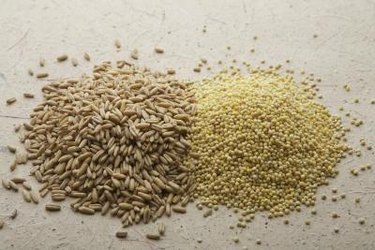
Rice is cultivated and consumed all over the world, making it the most popular grain globally. For people living in Asia, rice supplies 35 to 80 percent of caloric intake, according to Duke University. Couscous originates in North Africa and plays a central role in Middle Eastern cuisine. It is also common in Mediterranean cooking, and is continuing to gain popularity worldwide. You can use rice and couscous interchangeably in many recipes, but there are important differences between these grain-based products.
Definition
Video of the Day
When you eat rice, you are eating a kernel harvested directly from a plant. Couscous, in contrast, is produced from wheat; it is not rice at all, but a type of pasta. Rice cultivation dates back to at least 2500 B.C., while couscous has been around for only a thousand years, according to The Nibble, a specialty foods magazine.
Video of the Day
Types
Rice comes in dozens of varieties and several colors. Examples include long grain, short grain, sweet, basmati, jasmine, sushi and Himalayan rice. Couscous comes in only three main varieties: white, whole wheat and Israeli. White couscous is the softest of the three. Whole wheat couscous is similar in size to white couscous, but it has a nuttier flavor and firmer texture. Israeli couscous is larger, rounder and more pasta-like.
Nutrition
For optimal nutrition content, choose whole grain varieties of rice and couscous. Whole grains contain nutritious germ and bran, parts that are removed to make the softer, white grains. Whole grain rice contains more than 15 vitamins and minerals, including B vitamins, iron and zinc, while whole wheat couscous provides significant amounts of iron, zinc, selenium and fiber. Both couscous and rice, whole grain or not, supply carbohydrates, which provide fuel for physical activity.
Uses
In general, choose rice if you want a firmer, chewier texture; couscous if you want a softer grain that will readily soak up juices. Both work well for pilaf, hot breakfast cereal and casseroles. Couscous goes exceptionally well with soup. Place cooked couscous on the bottom of the bowl and pour hot soup on top. The two almost melt together into one dish. Do this with rice, and you simply get a soup with rice in it. If you plan to add uncooked grain to a simmering soup, however, rice is a better choice since couscous can quickly overcook.
Tips
Whole grain rice is often called brown rice, since the most common varieties of whole grain rice are brownish or tan in color. Whole grain rice, however, may be black, red or even purple, depending on the variety. Rice is the least allergenic of the grains, making it a suitable grain for most people, including those with gluten intolerance, according to the USA Rice Federation. If you are allergic to wheat -- and therefore couscous -- look for brown rice couscous. It is slightly firmer and coarser than wheat couscous, but is more like couscous than rice.